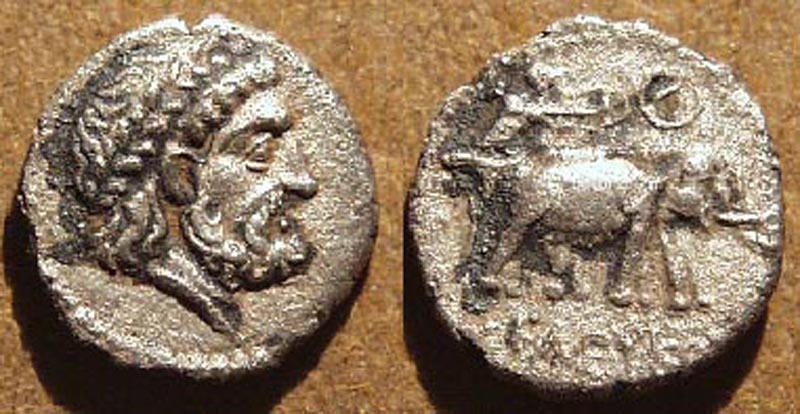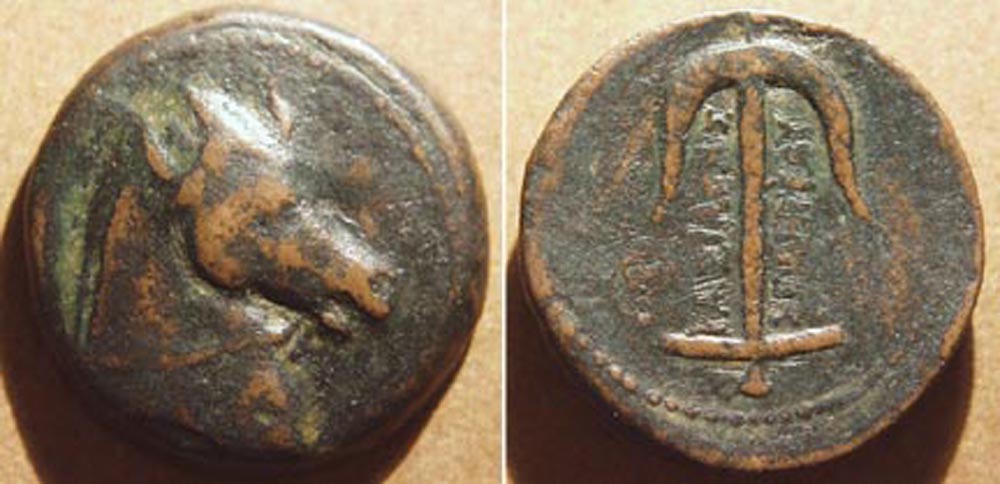
| Bactria: Seleucid
Seleucos I
Silver Tetradrachm, c. 290 BCE
Weight:16.87 gm., Diam:26 mm., Die axis:6h
Diademed, bearded bust of Zeus right/
Athena driving elephant quadriga
Greek legend: BAΣIΛEΩΣ ΣEΛEYKOY (of King Seleucos)
Ref: MIG 52 |
 |
This magnificent specimen of the Greek celator's art was issued by Seleucos I after he had established the Seleucid kingdom. Note the monogram for Bactra on the reverse (similar to the one we saw on the imitation Athenian owl of the so-called pre-Seleucid period). Also note the Seleucid anchor above. |

| Bactria: Seleucid
Seleucos I
Silver Obol, c. 290 BCE
Weight:0.55 gm., Diam:9 mm., Die axis:5h
Diademed, bearded bust of Zeus right/
Athena driving elephant biga
Greek legend: ΣEΛEYKOY (of Seleucos)
Ref: MIG 49 var. |
 |
This tiny jewel of a coin, at only 9 mm. shows the great skill of the Seleucid celators. The monogram, a Δ in a circle, has been shown by Kritt to be the mint-mark of Ai-Khanoum in northern Afghanistan. Mitchiner reports no legend on this coin, but this specimen clearly shows the name of Seleucos on the reverse. |

| Bactria: Seleucid
Seleucos I
Silver drachm, c. 290 BCE
Weight:4.22 gm., Diam:16-17 mm., Die axis:6h
Bust of horned horse right/ Seleucid anchor
Greek legend: BAΣIΛEΩΣ ΣEΛEYKOY (of King Seleucos)
Ref: Kritt, plate 5-X |
 |
Although there is no definitive evidence to support this, the horse represented on this coin is almost certainly Alexander's beloved horse, Bucephalus. |

| Bactria: Seleucid
Seleucos I
AE tetrachalkous, c. 290 BCE.
Weight:16.14 gm., Diam:25 mm., Die axis:7h
Bust of horned horse right/ Seleucid anchor
Greek legend: BAΣIΛEΩΣ ΣEΛEYKOY (of King Seleucos)
Ref: Kritt, plate 2-29 |
 |
This coin shows the bevelled edge that is seen on many copper coins from Ai-Khanoum. |

| Bactria: Seleucid
Seleucos I with his viceroy Antiochos
Silver Tetradrachm, after 293 BCE
Weight:16.83 gm., Diam:26 mm., Die axis:2h
Bust of Hercules right, with lion head-dress/
Zeus enthroned left, holding sceptre and eagle
Greek legend: BAΣIΛEΩΣ ANTIOXOY ΣEΛEYKOY
(of King Antiochos Seleucos) |
 |
In 293 BCE, Seleucos sent his son Antiochos to Bactria to serve as viceroy, and series of coins were issued that carried the names of both Antiochos and Seleucos. Presumably, this move was precipitated by the need to keep the outlying provinces under imperial control. Perhaps Seleucos sensed the early rumblings that led eventually to the Bactrian revolt around 255 BCE. |